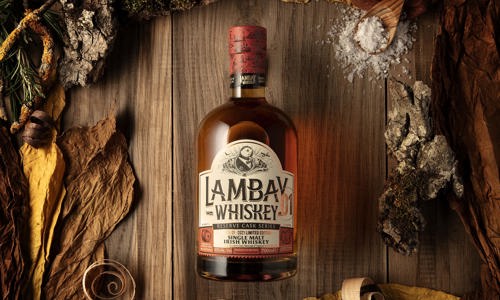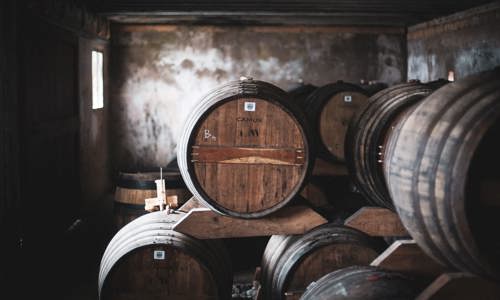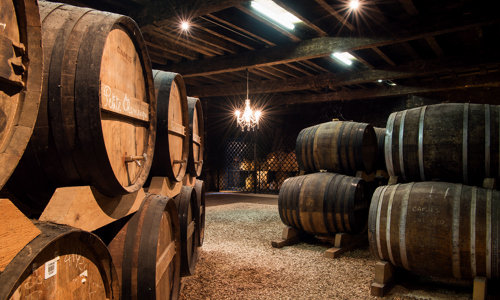Meet the Maker – Blending & Maturation
Lambay Whiskey had the esteemed pleasure to work with former Camus Maitre de Chais, and Patrick Leger when we began our journey back in 2017.
Leger’s experience and aptitude towards perfecting the ultimate cognac-cask finished Irish whiskey was and remains our mark of quality today. Early in 2019, we welcomed a new team member to the team who has gently stepped into his predecessors’ shoes for Lambay Whiskey – introducing our best-kept secret, Production Manager and Master of Maturation, Mr. Yonael Bernard.
Q: Where did your passion for spirits begin?
I belong to a long line of Master Distillers. My great-grandfather had his own small distillery in the Borderie area, in Cognac. My grandfather tried to continue this tradition but due to economic changing times in Europe and France, he was not able to continue. Later, my father re-ignited the family tradition and became a master distiller for a renowned Cognac House.
So, from an early age, I was surrounded by methods of distillation, aromas, and passionate people who loved producing spirits.
However, it was only after my studies that my real passion for production started. I worked on a project around firefighting in spirit warehouses to improve standards and due to visiting so many different cellars I couldn’t help but notice the wonderful and much-varied aromas within each caller. These aromas became my obsession and the need to understand flavour molecules began.
Q: What is your earliest memory of aroma and what was it?
I was from an early age aware of aromas, from the flowers on my local street to delicate perfumes and rich aromas from food and wine.
But one of the most memorable aromas for me was when I visited Lambay Island and the Sea Cask Room for the first time. In this isolated place, away from pollutants and surrounded by nature the aroma of those casks just hits you. The freshness and purity of the sea air mixed with the flora and compounds of nature deliver a unique richness that is different for each cask adding to the secret of the master blender.
Q: You are now the production manager for Lambay Whiskey – do you have a distillery?
No, we are not operating our own Distillery yet. We are essentially purchasing mature liquid in bulk and then managing the maturation and blending of our whiskey before it is then bottled on the mainland.
We do have plans to create a small micro-distillery on Lambay in the future, this depends on planning permissions and many other factors to build a distillery on a private island!
For now, my entire work is centered around managing the various components of our production process for Lambay Whiskey. Working between France and Ireland, I am responsible for ensuring the logistics of our liquid production meet our standards before maturation and blending begin. I then oversee blending and finishing with consistent testing and sampling between Camus labs and Ireland before bottling. I am also tasked with innovation for future new product development which is an exciting process for me where cask finishing is concerned.
Q: Are you based on Lambay?
No, Lambay is a very small private island, only 2.5 square kilometers and not open to shared public living. It is owned by the Baring family and I work closely with Alex Baring (Director & founder of LIWC) where I am lucky to be able to traverse over and back when working but I am based primarily in Cognac France.
Q: What impact do cognac casks have on Irish spirit distillate?
An awful lot, Cognac casks preserve intense aromas within each stave of the cognac cask. We work closely with the Cellar Master in Camus to ensure that the casks we receive are selected for their aromas and because they will blend perfectly with our whiskey. The cognac cask naturally delivers more intense fruit notes, aromas, and textures to our whiskey.
Q: Tell us more about the casks used to finish Lambay Whiskey?
Our casks come from the Camus Cellar in La Nerolle, Cognac France.
What volume are they? It depends, usually around 350 liters. Camus also likes to use small casks around 300 liters, so we generally choose the casks that are best for us. Otherwise, our bourbon cask is standard around 200liters.
Are they old casks or new? For the cognac cask, they are generally old casks, so it is natural to ascertain that they have absorbed plenty of fruit and rich aromas within the wood. The European oak is more porous to allow these dense flavours to embed within the oak. For the bourbon barrels, we are using the standard US barrels traditionally exported for Irish whiskey to keep the typicity of Irish Whiskey.
Q: Is maritime maturation a thing and if so why?
For sure! As wood is an organic matter, it breathes the external atmosphere as well as correlates with the internal reactions at play inside the cask. Simply put, Maturation is a liquid, (in our case whiskey) that is impacted by a resting period (maturation cycle) and is surrounded by a specific environment or atmosphere.
The atmosphere on Lambay is highly unique and has probably some of the highest percentages of environmental sea salt in Europe. Lambay is a small island, therefore the smaller the island the greater the influence of the sea. The high humidity, strong winds, and waves are additional parameters to increase the influence of the sea in the atmosphere. Phytoplankton and sea-spray aerosols are high therefore the air is devoid of pollutants or industrial deposits.
It is also a nature reserve with very little human activity, thereby the island can preserve its pure air and deliver a rich environment of positive ions, sea salt, and oxygen.
The more constant and unique your environment for maturation, the more intense the maturation process for your casks.
Q: What impact does the sea air have on cognac casks?
As the air on Lambay is rich in sea salt and pure sea-spray aerosols, it is natural to expect that this imparts a certain briny / salty note to the casks. However, it is really the interaction between the atmosphere that passes through the cask while resting on Lambay and the slow oxidizing effect which is perfect for imparting certain island botanicals and environmental compounds into the cask. We use French oak so there is an additional advantage as these casks are slightly more porous allowing for more contact between the air and our whiskey.
Q: What aromas are most expected from a cognac cask?
Each cask varies depending on the interaction with it’s liquid. But naturally dried fruits, raisins, and rancio notes develop from the previous cognac with added spices from the oak.
Apricot, cinnamon, pear, and vanilla are some of the many aromas that you can potentially find.
Q: How long does the whiskey rest in the cognac cask before bottling?
It depends, we have our own rules depending on our Small Batch Blend or Single Malt. Some rules for the Small Batch Blend specify 1-month minimum but after that, it depends on their own evolution. This is our process of constant testing and sampling to see what impact each period makes on the whiskey. Sometimes casks rest a few months, sometimes a few years. We are also making trials on longer aging which could lead to more mellow varieties of Lambay Whiskey.
Q: What is your favourite part of the process?
The aging on Lambay Island, being able to travel there and have a personal role to play in selecting the casks and ensuring the liquid is evolving to my specification.
Q: What challenges do you see the Irish Whiskey category having 5 years from now?
As the category grows, so too will the expectation of Irish Whiskey customers for transparency by seeing producers respect the technical profile and innovate with great liquid. Presently, there is a lot of demand for Irish Whiskey as it is a global trend spirit. Irish Whiskey has a lot of assets compared to other spirits with its long history for whiskey making and credible reputation, those assets are also recognised by consumers worldwide.
If consumers are trying Irish Whiskey only now for the first time, it is likely that in 5 years times they will buy an Irish whiskey because they love the taste, have evolved in their taste profiles and know what they are looking for.
For the future of Irish Whiskey, the category must remain consistent in quality and in taste, preserve the very special energy of the people around this great spirit, and remain the undisputed guardians of Irish Whiskey production so it continues to thrive as an industry for generations to come.
Q: Which whiskey do you enjoy most and how?
I appreciate most of the time to drink my whiskeys neat.
For Scotch, Glenmorangie is good quality, very fruity or alternatively an Oban single cask which is very smooth.
Otherwise, I like Dingle Whiskey. I was also very surprised with the high complexity of Powerscourt Distillery / Fercullen which I see both as having huge potential in the future.
When drinking with ice I would say a Redbreast.
As a professional who works in the industry, it is difficult to specify a whiskey as it depends a lot on the company you keep in these moments, but I will say that my best times have always been with Lambay Single Malt Single Cask Strength. 100% aged on Lambay, each cask is very different from the other and I am always surprised by how different the liquid can taste and how the spirit evolves.





